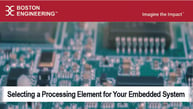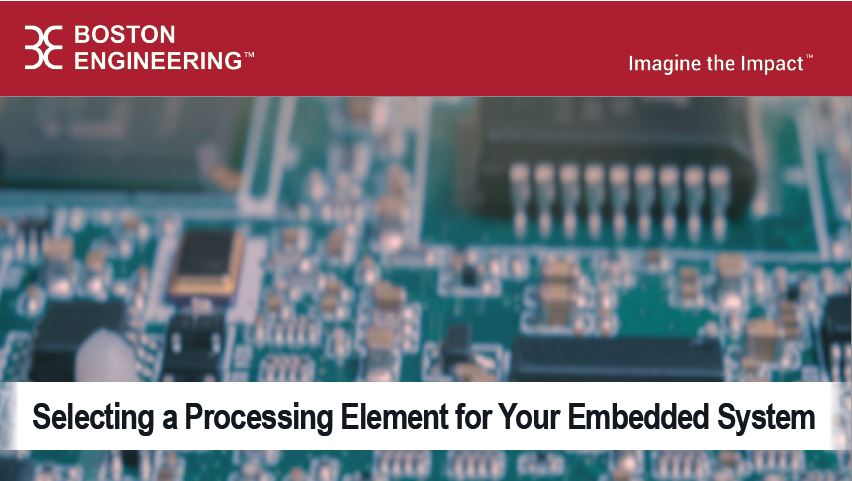Select and perform a trade analysis when Selecting a Processing Element for Your Embedded System
 This article is an excerpt from the Boston Engineering "Selecting a Processing Element for Your Embedded System" white paper. For a copy of the the complete publication, visit the Selecting a Processing Element for Your Embedded System download page.
This article is an excerpt from the Boston Engineering "Selecting a Processing Element for Your Embedded System" white paper. For a copy of the the complete publication, visit the Selecting a Processing Element for Your Embedded System download page.
5. Select, perform a trade analysis:
When it’s time to select a MCU, MPU, processor or FPGA ask yourself the following questions:
1. Who should be part of the team selecting the proccing element?
2. Do we have enough information to select the processing element?
Any major stakeholder should be part of the selection team and any minor stake holder should be consulted. The major stake holders should include at least one hardware engineer and one software engineer. Additional members of the team should include sourcing, program management and someone to represent the voice of the customer.
Embrace the future trends that are shaping a new era of engineering excellence.
Boston Engineering is a multidisciplinary engineering consulting firm that is often faced with the task of selecting a processing element (MCU, MPU, Single board computer, FPGA, SoC, or SoM) for an embedded system. This can be a simple or complicated task based on the project. Fortunately, one can take the same steps to select the processing elements for most embedded systems.
Download for groundbreaking insights!
It may be easy to select a processor given an understanding of the requirements and architecture for the product. This happens when the design is like a recent design in terms of the required I/O, targeted market, production quantity, and performance. If the selection is not obvious to the team, then a trade analysis of some sort is in order.
The driving requirements were that it was to Run ROS2 (and therefor needed a newer version of Linux), needed the I/O listed, and was to be low power and run of a voltage that worked with the robot’s battery voltages without a lot of power conversion. We also wanted to make sure that it was easy for the SW team to work with and that we would get good support if we ran into issues.
We found two processors that that met all the requirements, A Jetson SoM and a Variscite SoM. The selection between these processors was made by comparing them against requirements not listed in the trade matrix, such as environmental, processing speed and memory capacity and bandwidth, etc. These requirements were originally left off the trade matrix because this robotics application did not require a lot of processing capacity and memory resources. Any of the listed processors are likely to satisfy them.
A trade matrix can take many forms. Including weighting in the matrix and ranking compliance can emphasize some requirements over others. Another approach is to first list “must have” requirements and then list “nice to have requirements”. This approach allows for candidates that don’t meet a must have requirement to drop out early. This can save time when it comes to researching compliance to requirements.
Once a trade matrix is complete the selection is often easy to make. If it’s not, then review the candidates against requirements left off the trade matrix and meet with the selection team and discuss the candidates. This will often lead to a decision, or the identification of what information is needed to decide. Before finalizing the decision take some time to open the design tools and do the pin mapping on the project to make sure that all the required peripherals map to pins on the device. Your chosen part may support 2 USB 3.0 ports, 4 SPI ports, Gigabit Ethernet, 2 CAN ports, and 4 PWM outputs, but can they all be used simultaneously? If the pin mapping works out, then you can sleep a little better. If you want to sleep even better, then buy the development kit and run a few benchmarks that are representative of your application.
Once the team has decided on a MCU, MPU, Processor of FPGA it is prudent to communicate the decision to the larger development team and take the following steps:
1. Figure out how many development kits are re- quired and buy them.
2. Double check that the company has the devel- opment environment or get it.
3. Get samples on order so that you can build early prototypes.
4. Put the part on a planning BOM so that sourcing can start managing it.
For a copy of the the complete publication, visit the Selecting a Processing Element for Your Embedded System download page.
.png?width=760&height=133&name=Surgical%20Robotics%20(1).png)
As the engineering landscape continues to evolve, Boston Engineering is committed to proactively integrating cutting-edge technologies and methodologies into the solutions it delivers, ensuring that clients stay at the forefront of industry trends and maintain a competitive edge.
About the Authors
Aaron Pailes
Sr. Principal Systems Engineer, Boston Engineering
Aaron is a skilled and versatile engineer with a strong background in systems and design engineering. He has contributed significantly to various technological advancements, including side scan sonar platforms, innovative sonar nadir filling technology, security scanners, network monitoring equipment, and RADAR systems
Kathryn Stringer
Electrical Engineer, Boston Engineering
Kathryn designs diverse electrical prototypes for medical/defense sectors, adept in PCB design, testing, and rapid breadboard creation. She collaborates on custom electronics for medical devices and ROV applications.
Tanner Jameson
Electrical Engineer, Boston Engineering
Tanner is a Tufts University graduate, specializing in collaborative circuitry design, software and hardware integration, and product prototyping.
Ready to learn more about Boston Engineering?
For almost three decades, Boston Engineering has designed, developed, and optimized devices and technologies the medical, Commercial, and Defense communities rely on to improve the way people work and live. We provide solutions to the challenges society faces.
Our expertise includes industrial design and product redesign, sensors and control systems, robotics technical innovation, and digital software solutions.
Imagine your Impact: Stay up-to-date with the latest insights and trends we're watching. Add your email address below and sign up for a monthly summary of our most impactful posts!











